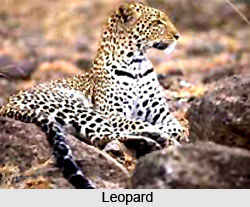 The Indian Leopard is one of the subspecies of the leopard and the scientific name of the Leopard is Panthera pardus. It is the fourth largest of the four` big cats` of the Panthera genus.
The Indian Leopard is one of the subspecies of the leopard and the scientific name of the Leopard is Panthera pardus. It is the fourth largest of the four` big cats` of the Panthera genus.
The length of a leopard is between one meter to two meter and weighs somewhere between thirty kilograms to seventy kilograms. Leopards have a well-built body and they have a head, which is larger in terms of body. A leopard can climb trees and are very good swimmers. The Leopards are nocturnal animals that are known to attack stealthy. They lead a solitary life and only occasionally they can be found roaming in a group of three or four. They have a good sense of hearing and also have sharp eyesight.
Leopards are carnivores who eat almost every animal from monkeys to reptiles to fish. The mating season of the leopards depends upon the areas they inhabit. The female usually remains in heat for six to seven days. They give birth to two to three cubs at a time. After three months the cubs goes with their mother for hunting and live with her for the next eighteen to twenty-four months.



















